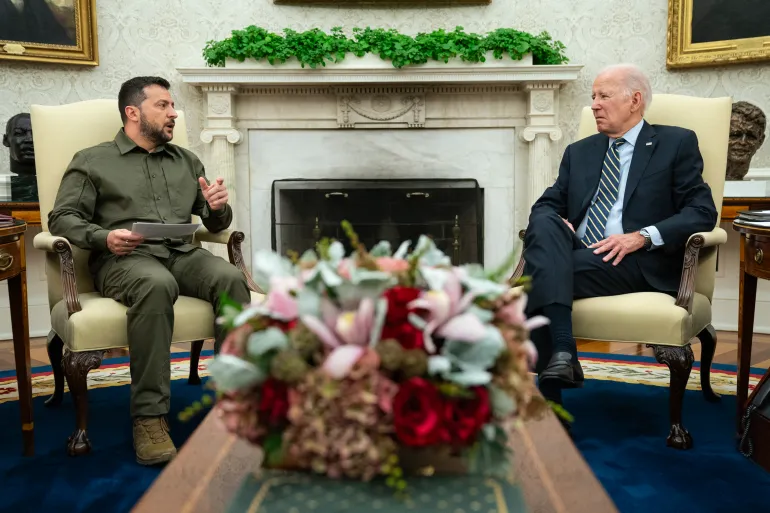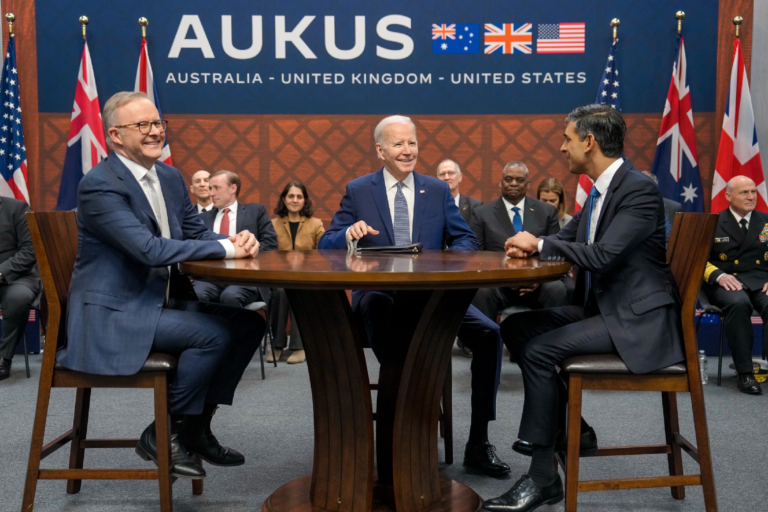As campaigning for next year’s United States presidential election heats up, Ukraine has emerged as a central theme.
President Joe Biden is currently scrambling to muster support for a new aid package for the war-torn country, facing hardening scepticism from Republicans in a deeply divided Congress.
His challenge just got harder, with hardline Republicans pushing through a vote that on Tuesday led to the ouster of the party’s own House of Representatives speaker, Joe McCarthy.
So what does this presage for Ukraine? Is the US, the country’s staunchest ally to date, about to scale down its generous aid packages? And, given its role in rallying support across the West, will others waver?
Where does the US Congress stand on Ukraine?
Recent developments, which saw Congress ditch provisions for further funding to avert a government shutdown, sent shock waves across the Atlantic. Biden is now pressing members of Congress to back a separate deal for Ukraine funding. He was relying on support from McCarthy, who was however removed from office on Tuesday.
Prior to his dramatic departure, McCarthy had already raised members’ concerns about accountability regarding funds sent to Kyiv. With some of his potential successors strongly in favour of continuing funding and others strongly opposed, who succeeds him could influence the flow of US aid to Ukraine – and potentially the direction of the war that started with Russia’s full-fledged invasion of its eastern neighbour in February 2022.
In the midst of the head-spinning drama, Biden had told Congress on October 1 that the “vast majority” of both parties in the Senate and Congress backed Ukraine in their fight against Russia’s “brutal aggression”.
However, while senators from both parties have shown unity on the subject, with dozens attending a meeting with Ukrainian President Volodymyr Zelenskyy during his visit to Washington in September, the House is more polarised. Republicans control the chamber by a narrow 221-212 majority.

How does Elon Musk fit into this equation?
The battle was thrown into sharp focus on Monday, October 2, when billionaire Elon Musk lashed out at Kyiv on his X social media platform (formerly Twitter), posting a meme featuring Zelenskyy with the caption: “When it’s been 5 minutes and you haven’t asked for a billion dollars in aid”.
Ukraine’s parliament hit back on its official X account, posting a meme of Musk with the words: “When it’s been 5 minutes and you haven’t spread Russian propaganda”.
Last month, Russian president Vladimir Putin hailed Musk as an “outstanding person” after revelations that the entrepreneur had stymied a Ukrainian attack on Russian-occupied Crimea last year, issuing orders that his Starlink satellite communications be turned off. Musk had allegedly feared Moscow would retaliate with nuclear weapons.
How much aid has the US given to Ukraine?
The US has thus far been a major backer of Kyiv, providing over $113bn in military, humanitarian and economic aid. Military spending, which accounts for more than half of US aid, pays for the drones, tanks and missiles crucial to the ongoing Ukrainian counteroffensive. Humanitarian assistance provides for medical supplies and essentials like food and safe drinking water for the displaced population.
Is that too much or too little?
Republican opponents of aid argue that the money should be spent on domestic concerns, such as border security, law and order, and relief for climate-related natural disasters hitting the country with increasing frequency. Aid to Ukraine is a considerable fraction of the $773bn defence budget request for 2023. It is far more than the $25bn slated for border security this year — a key bugbear for conservatives.
Department of Defense (DoD) Comptroller Michael McCord last month attempted to bring McCarthy onside, explaining that the Pentagon had already scaled down support. In a letter to the speaker, dated September 29, he highlighted the impact of foreign security assistance on jobs and production in congressional districts, mentioning facilities in Tuscon, Arizona and Camden, Arkansas.
Money is running low. As McCord pointed out, the DoD has only $1.6bn left to replenish military stocks flowing to Ukraine and a mere $5.4bn worth of Presidential Drawdown Authority (PDA). The Ukraine Security Assistance Initiative (USAI) has now been exhausted.
But, as the presidential campaign intensifies, such pleas are likely to go unheard. Military aid is simply not regarded as a winning campaign strategy. Hardline Republicans like Gaetz, a supporter of Donald Trump, the latter seeking re-election to the White House next year, look set to continue their drumbeat against aid in the coming months.
What’s at stake?
On October 3, the White House announced that Biden had spoken to the leaders of allied countries about continuing coordinated support.
In his annual address to the UN General Assembly last month, Biden attempted to counter war fatigue, which has become apparent in Europe, most notably in Poland and Slovakia.
“Russia believes that the world will grow weary and allow it to brutalise Ukraine without consequence,” he said. “But I ask you this: If we abandon the core principles of the United States to appease an aggressor, can any member state in this body feel confident that they’re protected?”
Beyond multilateralism, it’s also clear the US’s reputation as a global leader, shaken by its chaotic exit from Afghanistan in 2021, would suffer drastically if it walked away from Ukraine. Can Washington afford this at a time of rising tensions with Beijing?
None of this would have come as a surprise to Zelenskyy, struggling to beat back Russian forces before another harsh winter sets in. On his visit to Washington last month, dressed in military green, he reportedly described the situation to Senate Majority Leader Chuck Schumer in the baldest of terms.
“If we don’t get the aid, we will lose the war,” he said.
Source : AlJazeera







